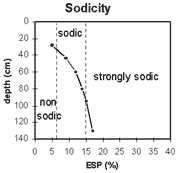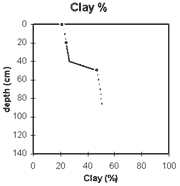NE39
| Property: Rutherglen Research Institute | Paddock #: 28 |
| Aust. Soil Class.: Bleached-Sodic, Eutrophic, Yellow DERMOSOL | Northcote Factual Key: Gn 4.6 |
| Great Soil Group: no suitable group | Map Unit: Rutherglen loam (brown phase) |
| General Landscape Description: Higher part of plain. | |
Soil Profile Morphology:
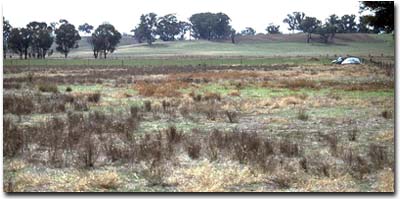
NE39 Landscape
Surface Soil
| A11 | 0-10 cm | Brown (10YR4/3); fine sandy clay loam; weak coarse blocky structure; weak consistence moist; pH 4.7; clear change to: | 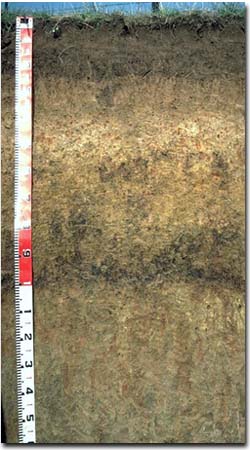 NE39 Profile |
| A12 | 10-20 cm | Brown (7.5YR4/4); fine sandy clay loam; weak coarse blocky structure; contains a few (2-5%) manganese nodules (2-5 mm size); pH 5.1; abrupt change to: | |
| A2 | 20-35 cm | Very pale brown (10YR7/4) [with patches of yellow (10YR7/6)] conspicuously bleached (7.5YR8/2d); fine sandy clay loam; weak coarse blocky structure; very firm consistence dry; contains a few (5-10%) hard clay and ferromanganiferous nodules; pH 6.7; clear change to: | |
| Subsoil | |||
| B1 | 35-50 cm | Very pale brown (10YR7/4); fine sandy clay loam (becoming light clay with depth); weak coarse polyhedral structure contains a few (2 - 5 %) hard clay and ferruginous nodules; pH 8.0; clear change to: | |
| B21 | 50-70 cm | Brownish yellow (10YR6/6); medium clay; moderate coarse polyhedral structure; (manganese stains present); pH 8.0; gradual change to: | |
| B23 | 70-90 cm | Very pale brown (10YR7/3) with brownish yellow (10YR6/6) mottles; medium clay; moderate coarse polyhedral, breaking to moderate medium polyhedral structure; contains manganese stains; pH 8.0; clear change to: | |
| B24 | 90-100 cm | Reddish yellow (7.5YR6/6); medium clay; moderate coarse polyhedral, breaking to moderate medium polyhedral structure; structure; contains very many (50%) manganese stains; pH 8.3; clear change to: | |
| B3 | 100-160+ cm | Light yellowish brown (10YR6/4) with yellowish red (5YR5/8) mottles; light medium clay; moderate coarse polyhedral, breaking to moderate medium polyhedral structure (shiny faced peds); firm consistence dry; pH 8.7. | |
Key Profile Features:
- Lack of strong texture contrast between surface (A) horizons and subsoil (B21) horizon.
- Presence of many manganese stains in deeper subsoil (ie. between 50 - 100 cm depth).
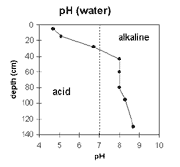 |
| 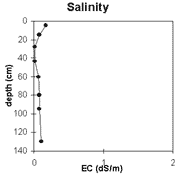 |
|
|
|
|
|
Management Considerations:
Whole Profile
- Plant available water capacity (PAWC) is considered to be low (estimated at 85 mm) for the top metre of the soil profile. This is based on available laboratory data.
- The surface soil is very strongly acid. Aluminium becomes more soluble in soils at low pH levels. The level of exchangeable aluminium measured in the surface horizon (78 ug/g) may restrict the growth of highly aluminium sensitive species. The level of exchangeable aluminium reduces to a low level in the subsurface (A12) horizon.
- Molybdenum deficiency may also occur in the strongly acid surface soil.
- The subsurface (A12 and A2) horizons disperse slightly-moderately after remoulding. Deep tillage should therefore be avoided if these horizons are in a moist to wet condition.
- The surface soil has a high fine sand and silt content. Organic matter is therefore important for maintaining aggregation and preventing slaking.
- The subsoil horizons are sodic and disperse. This will result in restricted root and water movement through the subsoil.
- The presence of a large amount of manganese staining in the mid subsoil (ie. between 50 - 100 cm depth) may have a toxic effect on deeper rooted manganese sensitive species.
- Disc ploughed (1971)

